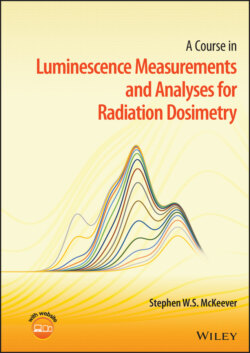Читать книгу A Course in Luminescence Measurements and Analyses for Radiation Dosimetry - Stephen W. S. McKeever - Страница 32
2.1.3 Non-Crystalline Materials
ОглавлениеAn obvious example of a material in which the infinite periodicity of the lattice cannot be expected is a non-crystalline or glassy material. The amorphous nature of such materials means that, at best, only short-range order can be expected and once several lattice distances are considered the material cannot be defined by regular order. As a result, the presence of defects such as those described in the previous sections results in a range of potential energies to describe the defect, depending upon the local environment. Furthermore, the energy states available to free electrons and holes must be reconsidered in such materials, as shown in Figure 2.5 where the density of allowed states of a crystalline material (Figure 2.5a) is compared with that of an amorphous material (Figure 2.5b). As with crystalline materials, allowed energy zones do exist, but with non-crystalline materials the density of states Z(E) partially extends into the gap, creating so-called band-tail states. Defect state energies are distributed rather than discrete and can extend above or below the Fermi Level, EF, such that Z(EF) ≠ 0. Localized energy levels (shaded in Figure 2.5b) require absorption of external energy (thermal or optical) to ionize the defects, i.e. to excite the charge carriers (electrons or holes) into the delocalized bands (conduction and valence bands). Thus, a non-crystalline solid can be treated in much the same way as a crystalline solid in the sense that the delocalized bands are separated by an energy gap (more correctly termed a “mobility gap” since Z(E) tail states extend into the gap) with localized states due to defects existing within the gap but with distributions of energy (band-tail states).
Figure 2.5 Density of states functions Z(E) for (a) a crystalline solid, and (b) an amorphous (non-crystalline) solid. For non-crystalline materials the density of states extends into the band gap (band-tail states) and localized states (shaded) are distributed in energy.
It should also be mentioned that even crystalline materials can exhibit band-tail states extending into the gap if they exhibit sufficient lattice disorder due to variations in bond lengths, bond angles, local density fluctuations, and/or contain high concentrations of impurities or other extrinsic defects. If the disorder is sufficiently high, it can give rise to a density of states Z(E) that extends into the band gap. Such materials may include, for example, natural minerals, such as the feldspar family or the various polymorphs of silicon dioxide.
